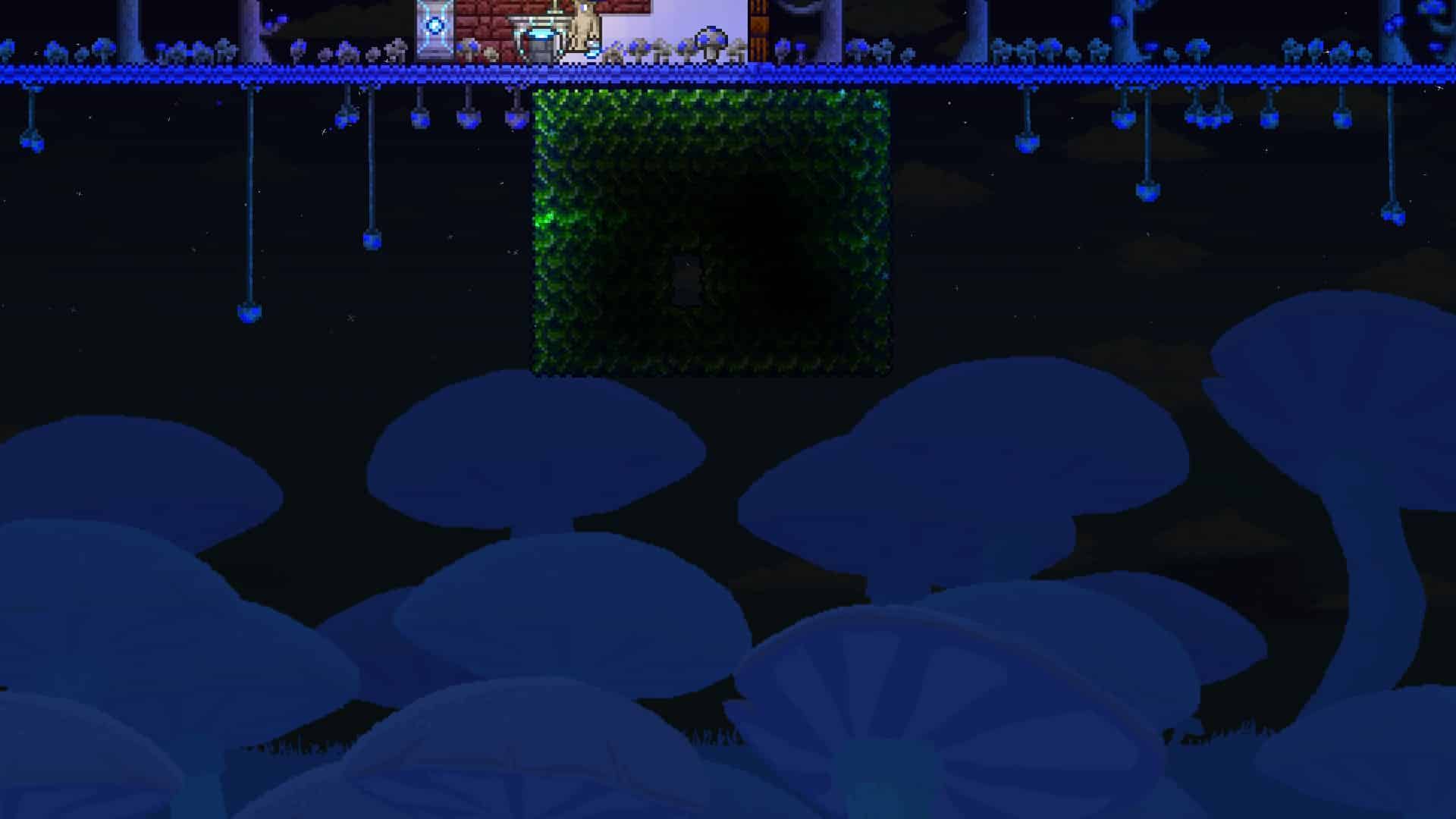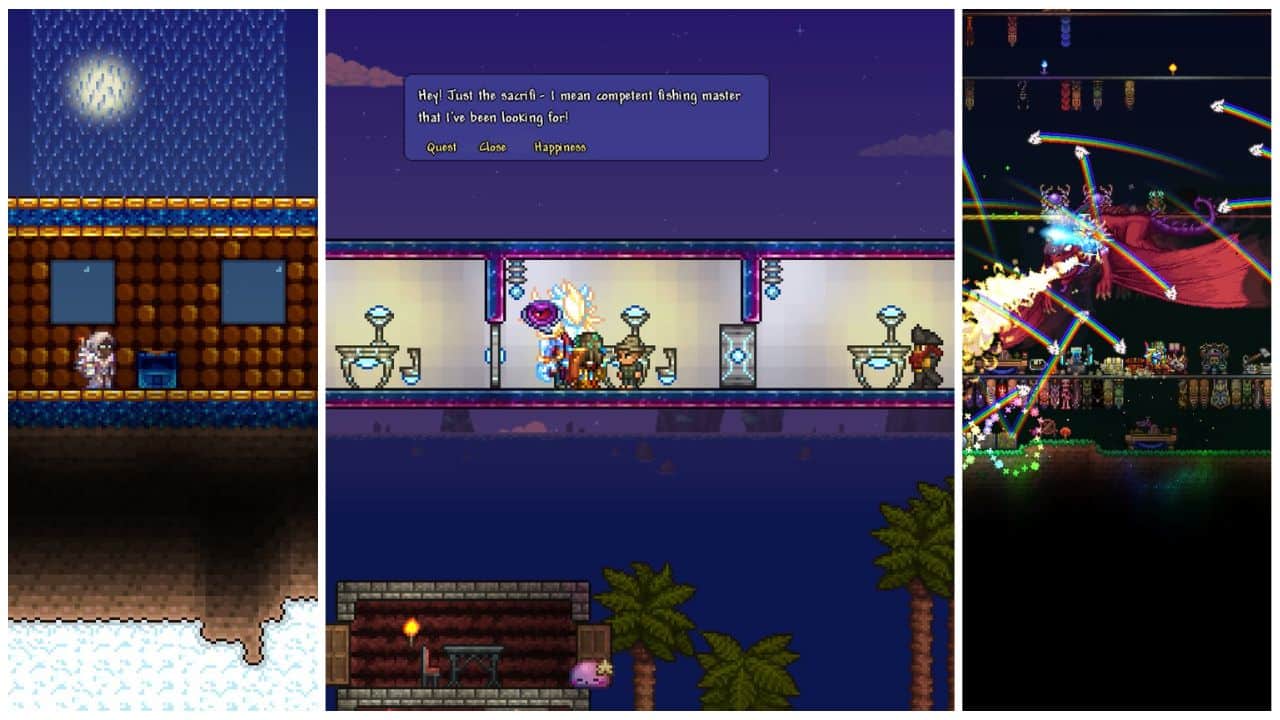
Making houses in Terraria involves more than just creating a rectangular structure on the ground. It needs careful planning and attention to detail to create a livable space for your NPCs to meet several requirements. However, you must consider your location, tiles, and materials in making a new home.
To help you get the best gaming experience, we’ll get you started on how to build a house in Terraria. We’ll simplify the process and help you create a place valid for your NPCs. Continue reading this guide to learn more.
WHAT MATERIALS CAN YOU USE TO MAKE A HOUSE?
In Terraria, Houses are vital for NPCs as their spawning points where they each get to have one. You can construct homes using Wood, Stone, and other material you can find to create walls and furniture. However, to prevent enemies from spawning within your home, you must avoid using Unsafe Walls, such as those made from Dirt and walls converted by the Biome spread.
HOUSE FRAME AND INTERNAL AREA
A House Frame is made up of solid tiles that completely enclose the home’s interior using non-actuated solid blocks or platforms and its doors. On the other hand, the Internal Area is composed of connected tiles in each direction.
While constructing your home’s frame and internal area, make sure that there are no holes in your walls, as this can allow enemies to get in. Lastly, to make your house in Terraria gets validated, it must have at least 60 tiles but less than 750 in total.
FURNITURE
After building the Frame and Internal Area, it’s time to add Furniture to spruce up the place and make it a livable space for NPCs. Each house requires at least one valid Entry, Comfort, Flat surface item, and Light Source. See the table below for the types of furniture in Terraria:
| Entry Items | Comfort Items | Light Sources | Flat Surface Items |
| Doors | Bar Stool | Candelabras | Alchemy Table |
| Platforms | Beds | Candles | Bathtubs |
| Tall Gate | Benches | Chandeliers | Bewitching Table |
| Trap Door | Chairs | Christmas Lights | Bookcases |
| Chippy’s Couch | Fireplace | Dressers | |
| Picnic Table | Hanging Brazier | Pianos | |
| Sofas | Heart Lantern | Picnic Table | |
| Throne | Jack ‘O Lantern | Tables | |
| Toilets | Jellyfish Jars | War Table | |
| Lamp Post | Work Benches | ||
| Lamps | |||
| Lanterns | |||
| Lavafly in a Bottle | |||
| Peace Candle | |||
| Shadow Candle | |||
| Skull Lantern | |||
| Souls in a Bottle | |||
| Tiki Torch | |||
| Torches |
PROPERTY REQUIREMENTS TO CONSIDER
Evil Score
Before building a house, remember not to place it inside or near an evil biome because it’ll increase your Evil score and render it invalid. This is because NPCs in Terraria can’t live in Corrupted or Crimsoned Areas.
To calculate the Evil Score, you must add up your Corruption and Crimson Tile Score, then subtract them from the Hallowed Tile and Sunflower scores. After that, if you get -50 points, your house will be Valid for Housing. However, if you get +50 points, it’s considered Invalid and a status message will pop up that it’s Corrupted. Lastly, if you get 300 points, your house is Not Valid for Housing.
Check out the table below for the tiles within the area and their effect on the Evil score:
| Tiles | ||
| +1 point per tile | -1 point per tile | – 40 points each |
| Corrupt grass | Hallowed grass | Sunflower |
| Ebonstone Block | Pearlstone Block | |
| Purple Ice Block | Pink Ice Block | |
| Ebonsand Block | Pearlsand Block | |
| Ebonsandstone Block | Pearlsandstone Block | |
| Hardened Ebonsand Block | Hardened Pearlsand Block | |
| Corruption thorny bushes | Short Hallowed plants | |
| Corruption Plants | Tall Hallowed plants | |
| Vile Mushroom | ||
| Crimson grass | ||
| Crimstone Block | ||
| Red Ice Block | ||
| Crimsand Block | ||
| Crimsandstone Block | ||
| Hardened Crimsand Block | ||
| Crimson thorny bushes | ||
Home Tile Score
For a house to be valid in Terraria, there must be at least one Home Tile where the NPC can stand. Moreover, this rectangular area is neither a Platform nor a bubble, allowing characters to pass freely.
There are two parts to calculating your Home Tile Score; for the first one, you’re going to subtract -5 points per tile occupied by objects, subtract -20 points for each tile occupied by a closed Tall gate or door, and subtract -20 points for each tile occupied by an Open Tall Gate and hinge of an Open Door. Then, add +5 points for each unactuated tile.
You can proceed to the second calculation if you score over 0. If you get a score below 0, the tile will be invalid, and you can’t move on to the next part of the Home Tile Score computation.
For the second part of the calculation, subtract -15 points for each solid tile around the valid Home Tile. You’ll also deduct -30 points per regular chest, including Locked Chests, except for Trap Chests per tile that it occupies within the surrounding area of a valid home tile. Lastly, if you assign a second NPC to an occupied house, their distance must be less than three tiles away from the home tile of the existing NPC to get a score of 1.
Here are some tiles not Included in the Home Tile Score computation:
- Herbs at any growing stage
- Mushroom
- Regular grass and Tall grass plants
- Torches
- Opened Trap Doors
Finally, if you receive a score of 0 or lower, your Home Tile is Invalid, while a score of 0 or higher means it’s valid.
STEP-BY-STEP GUIDE ON HOW TO BUILD A HOUSE IN TERRARIA
Here’s an easy step-by-step guide on how to make a simple house in Terraria using Wood. Read further to learn how to do it yourself, and we’ll add a variety of small house dimensions you can try!
Step 1: Gather Materials
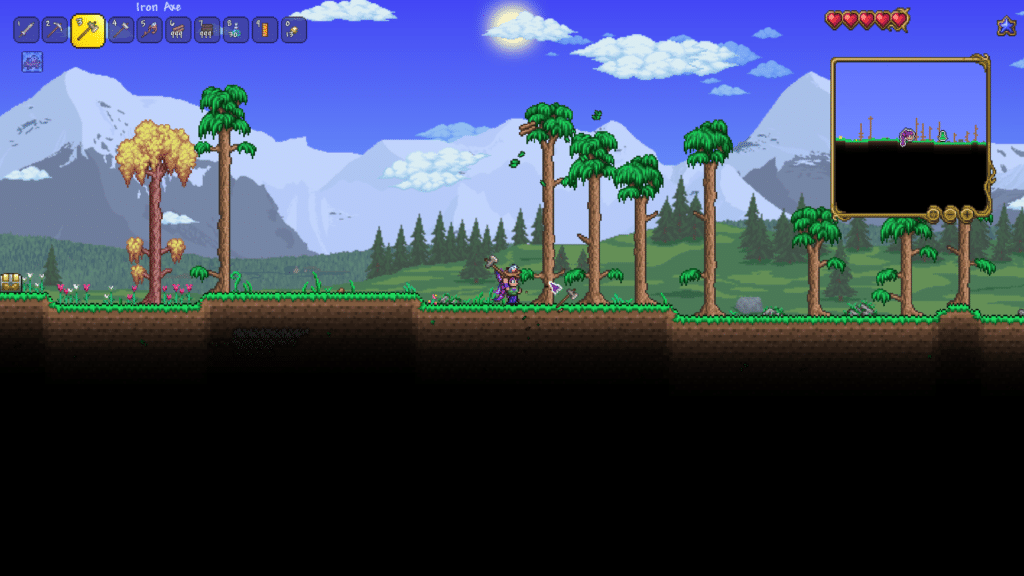
The first step is to gather all the materials you’ll need for the following steps. For this guide, we’re using Wood, a beginner-friendly material. However, you can experiment with other materials as the game progresses.
Step 2: Craft House Walls

The second step is to craft your House walls in Terraria using a workbench. Since we’re using Wood, we’ll make enough Wood Walls for the next step.
Step 3: Create an Internal Area
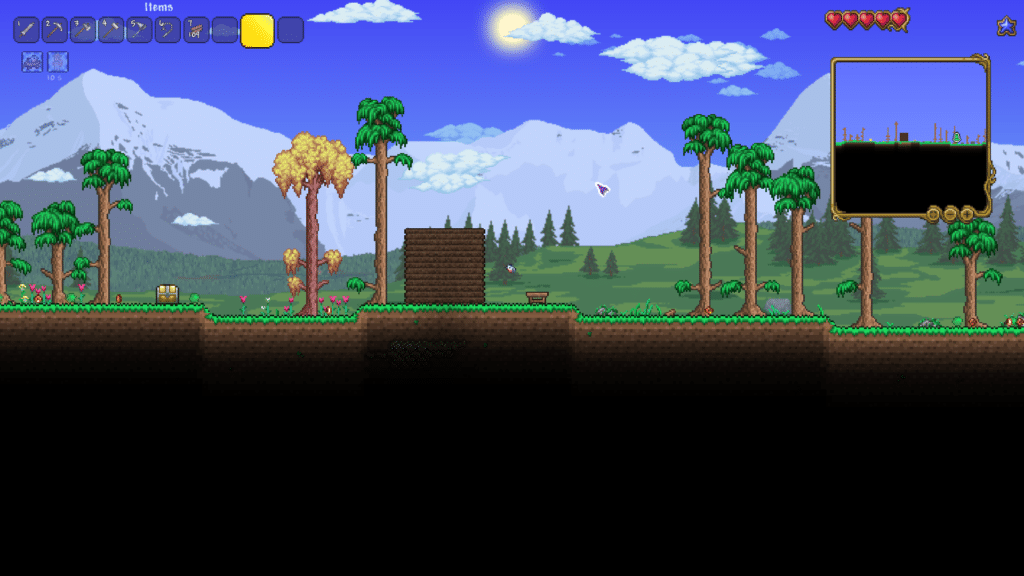
The third step is to create the internal area by placing your newly made house walls on flat ground away from Corrupted or Crimsoned areas. Next, we’ll set the Wood walls based on our preferred dimensions, as shown in the picture.
Step 4: Create a Frame
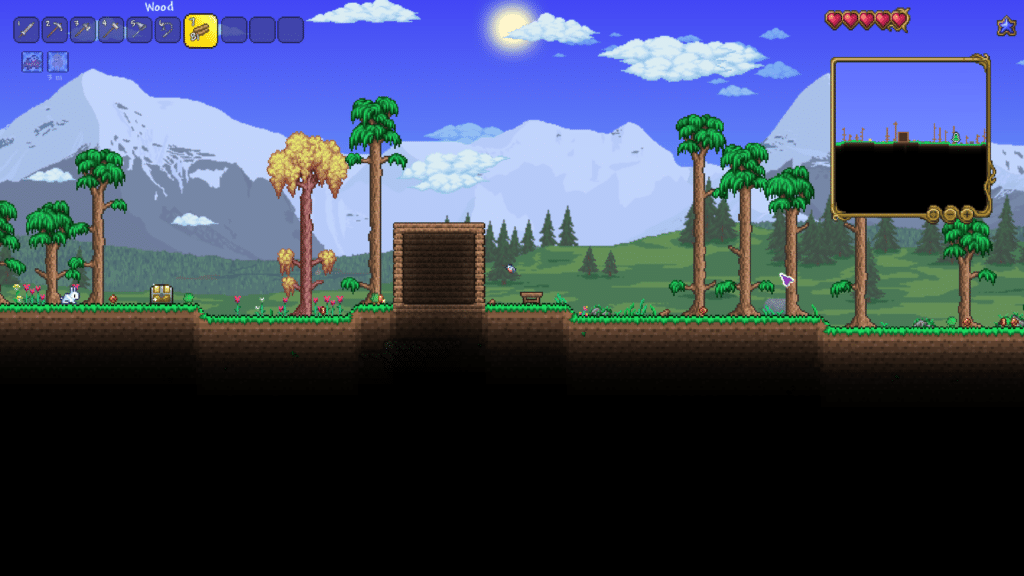
The fourth step is to create the house’s frame by simply using Wood and using it to encase the Internal area we made earlier. Thus, use it to construct the home’s ceiling, floor, and walls.
Step 5: Craft and Add Furniture
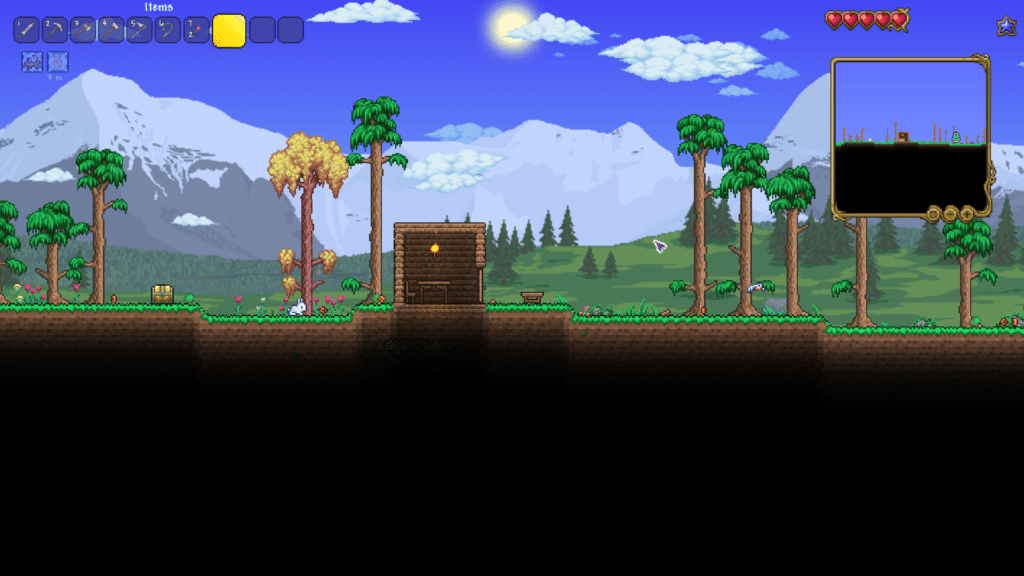
The fifth step is to craft one Light source, Entry, Comfort, and Flat surface item at the workbench. Then, add all the newly made furniture inside the house to furnish it and wait for it to be valid housing for a Terraria NPC.
Small House Dimensions
Rectangular houses must have at least one of the following dimensions to meet the minimum size requirement of 60 tiles while not exceeding 750 tiles.
| With Ceiling, Floor, and Walls (tiles width x tiles height) | Without Ceiling, floor, and walls(tiles width x tiles height) |
| 5 x 12 | 3 x 10 |
| 6 x 10 | 4 x 8 |
| 7 x 9 | 5 x 7 |
| 8 x 8 | 6 x 6 |
| 9 x 7 | 7 x 5 |
| 10 x 6 | 8 x 4 |
| 12 x 5 | 10 x 3 |
| 15 x 4 | 15 x 2 |
NPC HOUSING
After seeing the ‘This is valid housing’ status message, you can finally assign a house for an NPC or wait for one to move in. Here’s a list of NPCs that need and don’t need housing in Terraria:
Need Housing:
- Guide
- Angler
- Goblin Tinkerer
- Tavernkeep
- Mechanic
- Stylist
- Wizard
- Tax Collector
- Golfer
- Truffle
Note: Truffle NPC requires that its house must have at least 100 tiles of Glowing Mushroom biome blocks surrounding its home.
Don’t Need Housing:
- Old Man
- Traveling Merchant
- Skeleton Merchant
